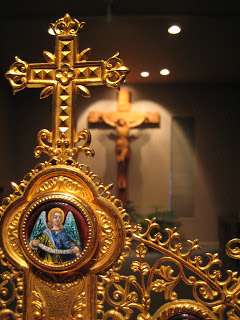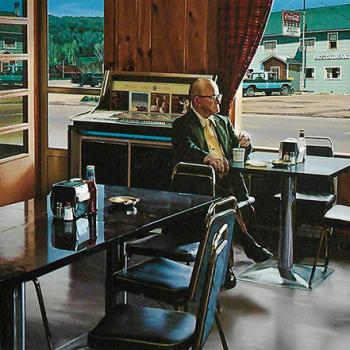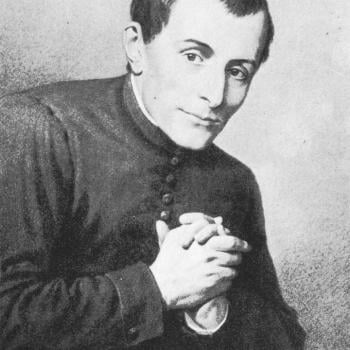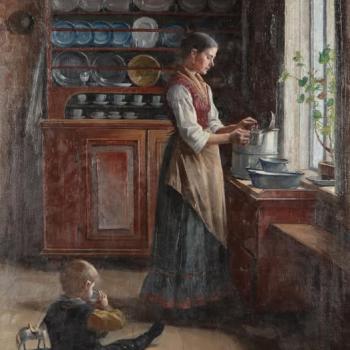MY OWN ENCOUNTERS WITH THE EUCHARIST IN THE CATHOLIC CHURCH
 For the last five years I have gone to a Catholic mass every week, sat in a pew and observed Catholics take part in communion. This Eucharistic celebration of the breaking of the bread and the drinking of the wine is what the Catholic Church calls the source and summit of the life and mission of the church. The celebration of the Lord’s Supper truly constitutes the primary reason Catholics gather to worship and establishes the very foundation for the propagation of the Catholic faith. I have witnessed this rite thousands of times, and yet have never been able to participate with the Catholics I worship with so often.
For the last five years I have gone to a Catholic mass every week, sat in a pew and observed Catholics take part in communion. This Eucharistic celebration of the breaking of the bread and the drinking of the wine is what the Catholic Church calls the source and summit of the life and mission of the church. The celebration of the Lord’s Supper truly constitutes the primary reason Catholics gather to worship and establishes the very foundation for the propagation of the Catholic faith. I have witnessed this rite thousands of times, and yet have never been able to participate with the Catholics I worship with so often.
As a protestant minister at these masses I initially attended as a spectator, coming to observe a different way to worship, I gradually began learning through the experience and eventually embracing the Catholic understanding of the Eucharist myself. The Catholic understanding of the Eucharist began as a simple curiosity to me but has become my pedagogue. In many ways the Eucharistic celebration has formed the backbone of how I have learned about what Catholics believe about God and about the world that God created, but it has been a backbone formed without direct experience.
In this post I hope to make a few observations about the character of the Eucharist in the Catholic Church in the twenty-first century, and some of the challenges that may lay ahead for its future. However I must confess, at this point, I only speak of it as an admirer. I only know the Eucharistic life of the Catholic Church through fascination and contemplation. I have not been invited to join in their celebration of the eschatological banquet. This vantage point offers me a unique perspective, potentially clouded by my own experiential naiveté but perhaps at the same time capable of elucidating distinctive considerations. As I offer a few reflections on the history and theology of the liturgy, my prayer remains that these thoughts might be of some value to those who regularly sit at the wedding supper of the Lamb and an introduction to the beauty of the Eucharist to those who do not.
WHAT DOES THE CATHOLIC CHURCH TEACH ABOUT THE EUCHARIST?
The Eucharist is a door; it is a threshold between God and man. In it Jesus’ flesh and blood, soul and divinity is encountered in a loaf of bread and a cup of wine. As the Church takes and eats this life-giving bread and saving cup they understand that they are entering into the bridal chamber with the risen Lord and become united with Him and incorporated into his body. In this action the Church enters into the procession that follows the ascension of Christ and emerges at a new vantage point of the Kingdom of God.
In the Eucharist the Church finds itself and “becomes what it is”. It raises its offering to God, and is offered in Christ with it. It enters into the world to come and encounters a vision for the world in which all the pain, frustrations, desires, and hunger are referred to their ultimate end. The Church remembers God in Christ and God remembers the Church. Each of these majestic affirmations warrants a much deeper exploration, and in the writings of the Church throughout history these mysteries have been explored abundantly. This is a significantly more mystical and extraordinary vision of what happens in the Lord’s supper in many of the reformation traditions that I have worked with in the past and as I learned more and more about it I became curious about how the church had developed and maintained this understanding throughout history.
THE CHURCHES STRUGGLES WITH UNDERSTANDING AND TAKING THE EUCHARIST
The Catholic Church has come to her understanding of the power and mystery of the Eucharist through many struggles. In the Eucharist’s demonstration of such an extraordinary union there is always a degree of cognitive dissonance. How could God and Man come together in such seemingly profane forms? It seems to assault common sense and practical sensibility. People wanted to make sense out of the mystery and intuit the celestial.
 Although the belief that Christ was truly present in the Eucharist was present in church teaching since its earliest days, in medieval Europe, scholars and theologians began to make attempts at understanding how exactly Christ was made present in the Eucharist using more definitive categories. Although many of these attempts drove the church to meditate on Christ’s mysteries more deeply at times the scholastic approach could sometimes diminish certain elements of the Eucharist in its insistence on highlighting other parts. When Jesus had broken the bread at the last supper he had told his disciples, “τοῦτό ἐστιν τὸ σῶμά μου” (this is my body), but what did that mean? There are two realities that are held in tension in this statement, the body and the bread. In the middle ages scholastic thinkers began to emphasize more and more the body and left aside the bread. Theologians like Paschasius Radbertus described the bread as an envelope that was simply used as a grace to help keep away the disgusting bloody mess that was contained within. The power of using the nourishing symbol of bread, and the significance of using the action of eating to consummate the celebration was diminished considerably. Even as the theology about the Eucharist matured, using Aristotelian cosmologies to communicate the meta-physical undercurrents of the sacramental celebration, the use of bread and wine became largely understood as an accident of history. Their nature as symbols had been lost in the analytical methodology of the scholastics.
Although the belief that Christ was truly present in the Eucharist was present in church teaching since its earliest days, in medieval Europe, scholars and theologians began to make attempts at understanding how exactly Christ was made present in the Eucharist using more definitive categories. Although many of these attempts drove the church to meditate on Christ’s mysteries more deeply at times the scholastic approach could sometimes diminish certain elements of the Eucharist in its insistence on highlighting other parts. When Jesus had broken the bread at the last supper he had told his disciples, “τοῦτό ἐστιν τὸ σῶμά μου” (this is my body), but what did that mean? There are two realities that are held in tension in this statement, the body and the bread. In the middle ages scholastic thinkers began to emphasize more and more the body and left aside the bread. Theologians like Paschasius Radbertus described the bread as an envelope that was simply used as a grace to help keep away the disgusting bloody mess that was contained within. The power of using the nourishing symbol of bread, and the significance of using the action of eating to consummate the celebration was diminished considerably. Even as the theology about the Eucharist matured, using Aristotelian cosmologies to communicate the meta-physical undercurrents of the sacramental celebration, the use of bread and wine became largely understood as an accident of history. Their nature as symbols had been lost in the analytical methodology of the scholastics.
As the liturgy was becoming more and more analyzed and defined in the world of scholastic scholars and theologians the Eucharist was becoming less a part of the everyday lives of individuals. The Eucharist, once seen as culminating in the act of eating and drinking began to be eaten less. Scholastic emphasis on the true physicality of the body and blood of Jesus present in the Eucharist led many to fear to take it at all. The transcendence of the elements began to overpower the eminence.
The bread and wine became seen less as objects that naturally drew people together by the eating and drinking of them and were presented as elements to be venerated from a distance. The bread became unleavened so that it might be preserved for veneration outside of the liturgy and the cup was restricted from being consumed by the laity altogether. The wedding supper of the lamb had been practically transformed into a cryptic theatrical administration. The spirituality of the people began to shift from participation of the table of fellowship with the Lord to popular devotions that were comprehensible to common individuals. Mass slowly moved from a place where people participated in the liturgy, to a place where people worshiped in tandem to the liturgy. People no longer looked to the liturgy as the place in which a group of individuals were integrated within the corporate body of Christ but rather a place where the body of Christ was transubstantiated for a group of individuals. Corporate Identity had obfuscated by an inflated sacerdotal relegation. This is not to say that the Eucharist had lost its power or centrality in the middle ages, but rather to highlight ways in which that power and centrality were not reflected in praxis. Although the Council of Trent did take steps to more clearly frame the Church’s understanding of the Eucharist, they failed to adequately address the deficiencies in practice and emphasis.
THE REFORMS OF THE TWENTIETH CENTURY
The twentieth century was marked by a number of dramatic changes in the liturgy which culminated in the reforms of Vatican II. Spurred on by the call for active participation in the liturgy by Pius X in Tra le sollicitudini the Church began to take steps to reconnect people with her liturgical life. These efforts culminated in the reforms made after Vatican II, which took dramatic steps to assure that the liturgy was accessible to the laity and that the actions and rubrics remained consistent with the heart of the liturgy, the communion of the faithful in the Eucharistic meal.
These reforms allowed the mass to be translated into vernacular languages, and allowed for more lay involvement in the mass. It also reasserted that the high mass with the bishop communing with full lay participation should be presented as the exemplar of what mass should look like rather than the private masses that had dominated the rubrical norms in the years since Trent.
CRITICAL QUESTIONS FOR THE FUTURE OF THE CHURCH
As a result of many of these reforms the practice of the Eucharist has once again become the center of the lives of many faithful Catholics; however there are still many critical questions which must be addressed by the Catholic Church in the twenty-first century. It has now been 50 years since Vatican II and it is clear that there are still some questions about the Eucharist which must be engaged if the Body of Christ is to be built up most effectively in the Eucharist.
- The first question the Church needs to ask is how she can more effectively institute the understanding of the Eucharist instituted at the Second Vatican Council. The ritual shifts made in response to the guidance of the Council placed the Eucharist more centrally as THE sacrament from which all sacraments find their source. However, there is still progress that can be made to more fully articulate this central reality. One example of this is the way in which the sacraments of initiation (baptism, confirmation, and the Eucharist) are still separated in common usage. These rituals were originally part of a singular rite which met its full consummation in the Eucharist. Reuniting these essential initiatory actions in the baptism of the young so that both the rite for adults and for children is focused on the Eucharist is one example of a possible movement in continuing the reform in response to the theological counsel offered by Vatican II. There may be other changes that might be beneficial to restore the Eucharist to its central role in the life of the Church. I don’t believe the Church is done thinking about the implications of the Council.
- Another major question that needs to be answered is how to address the theological limitations of the Aristotelian language that saturates terminology used to described the mystery of the Eucharist in a post-Aristotelian world. Since the late medieval period the Church has used the term “transubstantiation” to describe how the mystery of the Eucharist is functioning. At the time of its formulation, it was truly a brilliant way of reconciling the scholastic concerns of the day, with the truly mystical reality of the sacrament. However, in an age where the categories used to describe the Eucharist no longer define the cosmological categories people use to understand the world it is time to think seriously how the Church presents its understanding of the Eucharist.
- Another issue is the widespread apathy, and misunderstanding which seems to dominate the understanding of the Eucharist in the twenty-first century. Surveys of Catholics consistently show that the average understanding of what communion is, and why people should participate in it regularly, is abysmally deficient. In an age in which information can be disseminated effectively and relatively cheaply using new media outlets, this lack of education is indicative of a failure of the Church to seriously employ the new media in meaningful ways and to engage catechetically with the richness of the Church’s teaching. Although the Church is finally beginning to take the new opportunities for communication and evangelization seriously, there are still many issues that will need to be addressed if the Church has any hope of catechizing their members in an effective way.
- A fourth question the Church will need to address in the decades to come is the shift of worldview. In the last few decades there has been a seismic shift in how people interact with the world. Societies have become increasingly pluralistic and multi-cultural. As people are exposed to multiple communities and contexts on a daily basis, the modern and post-modern captivation with texts as the central foci for meaning and authority has eroded and relationships have become the normative context for communication. There is little respect given to systems of hierarchy and centralized authority. If the Church wishes to communicate the Eucharist as the powerful sacrament that brings about corporate unity and a true catholicity, it will need to address how the current structures within the magisterium no longer connect with the ways in which people think about the world.
These are all very complex and serious questions, and there are no easy answers that will be able to resolve them. I know I don’t have a clear path that I can offer through any of them. I do have hope though. In my own journey toward the Eucharist I have been amazed at the ways that the Church has continued to deepen her understanding of the power of this “sacrament of sacraments” in spite of the many difficulties she has faced. I truly believe that the Spirit that has guided the Church throughout the years is still at work. I am excited to continue to observe and learn more about who Jesus is as the church is driven to meditate more deeply on the mystery of Christ in response to these new challenges.











